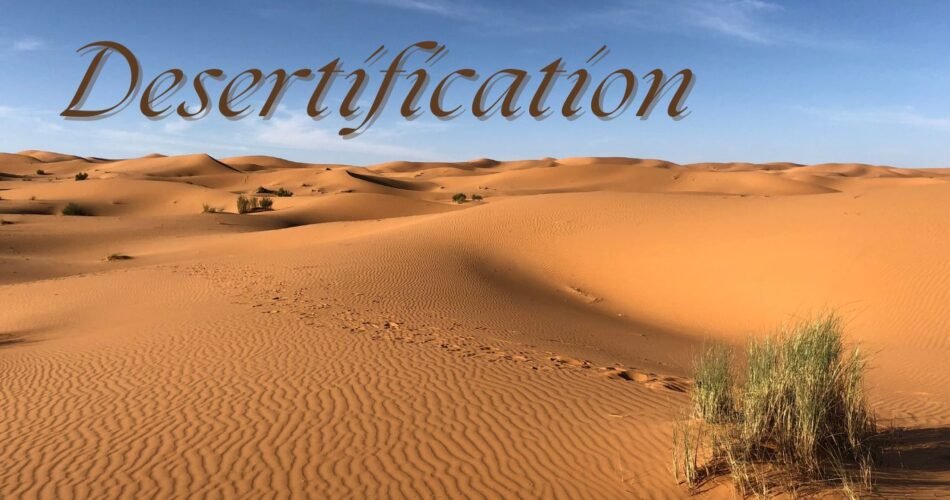This blog provides you information about Desertification. First we discussed the meaning of desertification. Then we studied about the causes of Desertification in detail. Second, we learnt about the effects of Desertification with explanation. In the end, we talked about the Preventive Measures of Desertification in detail. This blog contains Causes, Effects and Prevention of Desertification.
What is Desertification?
Desertification is a form of land degradation in arid, semi-arid, and dry sub-humid areas, primarily caused by human activities and climatic variations. It’s a global concern that threatens biodiversity, socio-economic development, and sustainability.
Desertification is the most common environmental issue now a days. Because of different causes, the fertile soil is converting into deserts or into barren land.
A cause can be inefficient use of irrigation water, cutting down of forests or natural climate change that makes an area extremely dry and make it a desert.
Desertification not only impact our crop production but also have some bad impacts on the environment. All the species living in deserted areas will change their habitat or loose their actual habitat.
We can prevent desertification by taking precautions on correct time so these precautions involves sustainable agriculture, afforestation, terrace farming and many other remedies can help us to avoid desertification. This blog contains Causes, Effects and Prevention of Desertification.
Causes of Desertification
The primary causes of desertification include:
Deforestation:
The removal of trees without sufficient reforestation. The deforestation done for the growth of crops, will never provide long-term results. When a forest is cut, it takes away important nutrients from the soil and the crops that are grown do not have sufficient nutrients. We should not change a forested land in an agricultural land because it can turn the land into desert.
Overgrazing:
Livestock consume vegetation faster than it can naturally regrow. Overgrazing means that the livestock are eating the grass from a specific area more than a certain limit. It is the main reason for erosion and erosion can cause desertification in a short time. Erosion cause dryness and dryness results in desertification. So, if you need to prevent desertification, you should avoid overgrazing.
Inappropriate Irrigation:
Poor irrigation practices lead to salt accumulation in the soil. Irrigation practices must be relevant to the type of crops that are irrigated. Some need large amounts of water and some need a little water. The irrigation system must be efficient according to the crop. Otherwise crop can damage and lack of water can make it dry and the soil can become deserted.
Urban Sprawl:
Expansion of urban areas into drylands. It is known as the expansion of cities because of the population growth. This cause extremely disturbing land-use change and cause the land to dry out. The land which was fertile, due to dryness and nearby construction converts into a barren land and cause the crops to be damaged and dry out.
Climate Change:
Alters precipitation patterns and increases the frequency of droughts. As we know that climate change is a rapid process in these years. This is causes drying out of areas, floods, tsunamis, and many other natural hazards that are impacting humans at a great extent. In the same way, the climate change is increasing the risk of drought in dry areas.
Effects of Desertification
Desertification has far-reaching impacts:
Loss of Biodiversity:
Ecosystems and species that cannot adapt to the drier conditions are lost. As the result, the species that took shelter and lived in that area, will loose their habitat so this can cause them to migrate or killed by the environmental conditions or eaten by any hunter. In this way desertification cause biodiversity loss at a great extent. In the same way all the crops grown in that area are also lost.
Food Insecurity:
Reduction in land productivity leads to lower crop yields. As the fertile soil has turned into barren soil, so the amount of crops will not be provided just as previous records. This leads to the food insecurity of the region. It means that there would be shortage of food for the people living in a specific region.
Water Scarcity:
Degraded lands retain less water, exacerbating water shortages. The water holding capacity of the barren land is much lower and negligible as compared to a fertile soil. Desertification is directly related to water scarcity as in this condition all the water present into the soil is dried out and no plants can be grown in that land again.
Economic Loss:
Decreased agricultural output can lead to economic instability. As the yield will be less, the economic loss will start to rise. It would be difficult to manage the economic loss and it will also cause food insecurity at the same time. The only way to withstand the loss, we should grow same yield of the crop in any fertile area.
Migration:
As lands become less habitable, people are forced to move, potentially causing conflict so Migration will cause many impacts to the economy and status of the area. People will prefer to live in a green and fertile area as compared to a deserted area. So, this can lead to extreme economic and social conditions for the people living in deserted area.

Preventive Measures
To combat desertification, several strategies can be implemented:
Afforestation:
the process of planting trees in areas where there were no forests previously, either because they never existed or were removed long ago. It involves a range of activities from planting new forests to creating green spaces within urban environments so the goals of afforestation are to improve air quality, enhance biodiversity, combat desertification, and mitigate climate change by absorbing carbon dioxide from the atmosphere. It can be done through natural regeneration, agroforestry, or tree plantations, depending on the specific objectives and environmental conditions of the area so Afforestation is a key strategy in creating sustainable ecosystems and promoting environmental conservation.
Sustainable Agriculture:
A farming approach that aims to meet society’s current food and textile needs without compromising the ability of future generations to meet their own needs so it involves environmentally friendly methods that enhance environmental quality, make efficient use of resources, and integrate natural biological cycles and controls. Sustainable agriculture practices include crop diversity, crop rotation, use of green manures, and organic farming, all of which help maintain soil productivity, reduce the need for chemical inputs, and support biodiversity. This approach also emphasizes socioeconomic equity and the economic viability of farm operations, contributing to the well-being of farmers and society.
Soil Conservation:
The practice of protecting the topmost layer of soil from erosion and preventing its fertility from reduction due to overuse, acidification, salinization, or chemical contamination. It involves a variety of methods such as:
Contour ploughing:
Plowing along the contours of the land to reduce runoff and soil erosion.
Terrace farming:
Creating stepped levels on a slope to slow water flow and reduce erosion.
Windbreaks:
Planting rows of trees or shrubs to reduce wind speed and protect soil.
Cover crops:
Growing certain crops to protect and enrich the soil during off-seasons.
Crop rotation:
Alternating crops in a field to improve soil health and reduce pests.
These practices help maintain healthy soils, which are vital for plant growth, water filtration, and so as a carbon sink to mitigate climate change. Soil conservation is essential for sustainable agriculture and the overall health of ecosystems.
Water Management:
We can do it with efficient irrigation system and practices.
Water Storage:
Constructing earth dams to store rainwater during the wet season for use in irrigation during dry periods.
Drip Irrigation:
Employing drip irrigation systems where water drips slowly from hoses, minimizing water loss and maximizing effectiveness, often powered by solar pumps.
Magic Stones (Bunds):
Placing circles of stones on the ground to retain water on the soil rather than letting it run off quickly.
This blog contains Causes, Effects and Prevention of Desertification.

Conclusion:
In conclusion, desertification is a complex issue with significant environmental, social, and economic implications. Addressing it requires a multifaceted approach that includes scientific understanding, community involvement, and strong policy support. By taking proactive steps, we can work towards mitigating the effects of desertification and preserving our planet’s dryland ecosystems for future generations. This blog contains Causes, Effects and Prevention of Desertification.
To learn more click the links below:


Comments